Deck 4: Force
Question
Question
Question
Question
Question
Question
Question
Question
Question
Question
Question
Question
Question
Question
Question
Question
Question
Question
Question
Question
Question
Question
Question
Question
Question
Question
Question
Question
Question
Question
Question
Question
Question
Question
Question
Question
Question
Question
Question
Question
Question
Question
Question
Question
Question
Question
Question
Question
Question
Question
Question
Question
Question
Question
Question
Question
Question
Question
Question
Question
Question
Question
Question
Question
Question
Question
Question
Question
Question
Question
Question
Question
Question
Question
Question
Question
Question
Question
Question
Question

Unlock Deck
Sign up to unlock the cards in this deck!
Unlock Deck
Unlock Deck
1/86
Play
Full screen (f)
Deck 4: Force
1
An elevator,with a total mass of 454 kg,accelerates downward at 3.51 m/s2.During this time,the tension in the elevator cable is
A)1594 N.
B)2426 N.
C)2860 N.
D)3354 N.
E)4454 N.
A)1594 N.
B)2426 N.
C)2860 N.
D)3354 N.
E)4454 N.
2860 N.
2
Two objects are not in contact,but they affect each other via gravity,and there are no other forces acting on either object.Which statement is always true?
A)The magnitude of the force of gravity is the same on both objects.
B)The direction of the force of gravity is the same on both objects.
C)The magnitude of the acceleration is the same for both objects.
D)The direction of the acceleration is the same for both objects.
A)The magnitude of the force of gravity is the same on both objects.
B)The direction of the force of gravity is the same on both objects.
C)The magnitude of the acceleration is the same for both objects.
D)The direction of the acceleration is the same for both objects.
The magnitude of the force of gravity is the same on both objects.
3
A skydiver of mass 90.0 kg (including outfit and equipment)floats down suspended from his parachute,having reached terminal speed,8.35 m/s.The area of his parachute is 40.0 m2 and the density of air is 1.15 kg/m3.The drag coefficient is
A)0.490.
B)0.521.
C)0.533.
D)0.551.
E)0.560.
A)0.490.
B)0.521.
C)0.533.
D)0.551.
E)0.560.
0.551.
4
A 100-kg object rests on a level surface with a coefficient of friction (both static and kinetic)of 0.40.If a 250 N force is applied,find the magnitude of the acceleration of the object.
A)0 m/s2
B)1.4 m/s2
C)2.1 m/s2
D)6.4 m/s2
A)0 m/s2
B)1.4 m/s2
C)2.1 m/s2
D)6.4 m/s2

Unlock Deck
Unlock for access to all 86 flashcards in this deck.
Unlock Deck
k this deck
5
Two blocks,B1 and B2 with masses of 12.0 kg and 5.60 kg,respectively,are in contact with each other on a frictionless horizontal surface.A purely horizontal force of 30.0 N is applied to B1,which in turn pushes B2 and both blocks accelerate together uniformly.The net horizontal force acting on B2 is
A)9.55 N.
B)15.0 N.
C)20.5 N.
D)30.0 N.
E)60.0 N.
A)9.55 N.
B)15.0 N.
C)20.5 N.
D)30.0 N.
E)60.0 N.

Unlock Deck
Unlock for access to all 86 flashcards in this deck.
Unlock Deck
k this deck
6
The two blocks in the figure have masses M1 and M2 such that M1 < M2 and they lay on a level,frictionless surface.We can apply a horizontal force F either from the left or from the right,as depicted in the figure.The contact force between masses M1 and M2 is 
A)the same in either case.
B)larger when F is applied from the left.
C)larger when F is applied from the right.
D)zero newtons.
E)impossible to determine based on this data.

A)the same in either case.
B)larger when F is applied from the left.
C)larger when F is applied from the right.
D)zero newtons.
E)impossible to determine based on this data.

Unlock Deck
Unlock for access to all 86 flashcards in this deck.
Unlock Deck
k this deck
7
A 100-kg object moves on a level surface with a coefficient of friction of 0.40.If the initial velocity is 15 m/s,how long will it take for it to come to rest?
A)1.5 s
B)3.8 s
C)6.7 s
D)37.5 s
A)1.5 s
B)3.8 s
C)6.7 s
D)37.5 s

Unlock Deck
Unlock for access to all 86 flashcards in this deck.
Unlock Deck
k this deck
8
In order to straighten a crooked tree,a rope is attached horizontally from the top of the tree to a nearby building.A force of 600 N is applied downward at the center of rope.The angle between this downward force and the rope going to the tree is 95 degrees,which is the same as the angle between the downward force and the rope going to the building.The tension in the rope going to the tree is
A)300 N.
B)600 N.
C)1200 N.
D)3442 N.
E)3658 N.
A)300 N.
B)600 N.
C)1200 N.
D)3442 N.
E)3658 N.

Unlock Deck
Unlock for access to all 86 flashcards in this deck.
Unlock Deck
k this deck
9
A climber pulls on a rope that goes through a single pulley directly above him and then comes back down to an attachment point on his belt.The climber has a mass of 65 kg.The force with which the climber must pull on the rope in order to support himself on the rope is
A)1275 N.
B)638 N.
C)319 N.
D)1913 N.
E)213 N.
A)1275 N.
B)638 N.
C)319 N.
D)1913 N.
E)213 N.

Unlock Deck
Unlock for access to all 86 flashcards in this deck.
Unlock Deck
k this deck
10
There are only two forces on an object that has a mass of 10.0 kg.Both forces have a magnitude of 10.0 N.The angle between the forces is 60.0 degrees.What is the magnitude of the object's acceleration?
A)2.00 m/sec2
B)1.73 m/sec2
C)1.50 m/sec2
D)1.41 m/sec2
A)2.00 m/sec2
B)1.73 m/sec2
C)1.50 m/sec2
D)1.41 m/sec2

Unlock Deck
Unlock for access to all 86 flashcards in this deck.
Unlock Deck
k this deck
11
Two masses,m1= 3.0 kg and m2 = 4.0 kg rest on a frictionless surface as shown.A force of 7.0 N is applied to m1.What is the acceleration of the two masses? 
A)1.0 m/s2
B)2.5 m/s2
C)3.0 m/s2
D)3.5 m/s2

A)1.0 m/s2
B)2.5 m/s2
C)3.0 m/s2
D)3.5 m/s2

Unlock Deck
Unlock for access to all 86 flashcards in this deck.
Unlock Deck
k this deck
12
A skydiver of mass 90.0 kg (including outfit and equipment)floats down suspended from his parachute,having reached terminal speed of 12.3 m/s.The drag coefficient is 0.533,and the density of air is 1.15 kg/m3.The area of her parachute is
A)40.0 m2.
B)38.0 m2.
C)30.0 m2.
D)23.0 m2.
E)19.0 m2.
A)40.0 m2.
B)38.0 m2.
C)30.0 m2.
D)23.0 m2.
E)19.0 m2.

Unlock Deck
Unlock for access to all 86 flashcards in this deck.
Unlock Deck
k this deck
13
An 85.0-kg snowboarder slides down a frictionless slope inclined at an angle of 30 .What is her acceleration?
A)1.18 m/s2
B)2.49 m/s2
C)4.91 m/s2
D)9.81 m/s2
A)1.18 m/s2
B)2.49 m/s2
C)4.91 m/s2
D)9.81 m/s2

Unlock Deck
Unlock for access to all 86 flashcards in this deck.
Unlock Deck
k this deck
14
A force of 100.0 N is applied to an object of mass 85.0 kg.What is the object's acceleration?
A)1.18 m/s2
B)2.49 m/s2
C)4.91 m/s2
D)9.81 m/s2
A)1.18 m/s2
B)2.49 m/s2
C)4.91 m/s2
D)9.81 m/s2

Unlock Deck
Unlock for access to all 86 flashcards in this deck.
Unlock Deck
k this deck
15
A package rests on the back seat of your car.The coefficient of friction between the seat and the package is 0.24.Assuming you drive on a level road,what is the maximum acceleration your car can have if the package is to remain in place relative to your back seat?
A)1.0 m/s2
B)2.4 m/s2
C)3.0 m/s2
D)3.5 m/s2
A)1.0 m/s2
B)2.4 m/s2
C)3.0 m/s2
D)3.5 m/s2

Unlock Deck
Unlock for access to all 86 flashcards in this deck.
Unlock Deck
k this deck
16
The mass of an object is
A)equal to its weight on the surface of the Earth.
B)equal to its weight in deep space.
C)never equal to its weight.
D)sometimes equal to its weight.
A)equal to its weight on the surface of the Earth.
B)equal to its weight in deep space.
C)never equal to its weight.
D)sometimes equal to its weight.

Unlock Deck
Unlock for access to all 86 flashcards in this deck.
Unlock Deck
k this deck
17
What determines the magnitude of the force of static friction on an object at rest at all times on a flat level horizontal surface being pushed to the right by another solid object?
A)the magnitude of the normal force in the vertical direction
B)the magnitude of the normal force in the horizontal direction
C)the object's weight
D)None are correct.
A)the magnitude of the normal force in the vertical direction
B)the magnitude of the normal force in the horizontal direction
C)the object's weight
D)None are correct.

Unlock Deck
Unlock for access to all 86 flashcards in this deck.
Unlock Deck
k this deck
18
The direction of the normal force is always
A)parallel to the surface of contact.
B)perpendicular to the surface of contact.
C)opposite the direction of the gravitational force.
D)None are correct.
A)parallel to the surface of contact.
B)perpendicular to the surface of contact.
C)opposite the direction of the gravitational force.
D)None are correct.

Unlock Deck
Unlock for access to all 86 flashcards in this deck.
Unlock Deck
k this deck
19
Four weights,of masses m1 = 3.00 kg,m2 = 1.00 kg,m3 = 4.00 kg,m4 = 2.00 kg,are hanging from the ceiling as shown.They are connected to each other with ropes.The tension in the rope connecting the masses m1 and m2 is 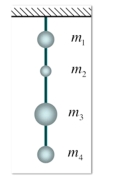
A)184 N.
B)98.1 N.
C)68.7 N.
D)58.9N.
E)19.6 N.

A)184 N.
B)98.1 N.
C)68.7 N.
D)58.9N.
E)19.6 N.

Unlock Deck
Unlock for access to all 86 flashcards in this deck.
Unlock Deck
k this deck
20
A force is applied to a 100-kg go-cart to accelerate it from 10.0 m/s to 20.0 m/s over a 7.00 s time frame.If the acceleration is assumed to be constant over the time frame,what is the magnitude of the force applied?
A)50.0 N
B)123 N
C)143 N
D)150 N
A)50.0 N
B)123 N
C)143 N
D)150 N

Unlock Deck
Unlock for access to all 86 flashcards in this deck.
Unlock Deck
k this deck
21
A 2.0-kg object,initially at rest at the origin of x-y coordinate system,is subjected to two forces,Fx in the positive x-direction,and Fy in the positive y-direction,whose time-varying magnitudes are shown in graphs below.What is the direction in which the object is travelling at t = 2 s? 
A)24.6º
B)36.6º
C)72.6º
D)81.6º
E)57.6º

A)24.6º
B)36.6º
C)72.6º
D)81.6º
E)57.6º

Unlock Deck
Unlock for access to all 86 flashcards in this deck.
Unlock Deck
k this deck
22
A 2-kg block of ice slides frictionlessly down a plane inclined at 22 a distance of 2 m.What is the normal force on the block of ice?
A)3.0 N
B)18.2 N
C)7.3 N
D)0 N
E)39.2 N
A)3.0 N
B)18.2 N
C)7.3 N
D)0 N
E)39.2 N

Unlock Deck
Unlock for access to all 86 flashcards in this deck.
Unlock Deck
k this deck
23
A wooden crate is at rest on a wooden ramp.(µs = 0.50;µk = 0.20;g = 9.8 m/s2).Find the angle of the ramp for which the crate will start sliding down the ramp. 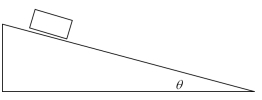
A)26.6
B)63.4
C)32.6
D)57.4
E)45.0

A)26.6
B)63.4
C)32.6
D)57.4
E)45.0

Unlock Deck
Unlock for access to all 86 flashcards in this deck.
Unlock Deck
k this deck
24
How far does a 5-kg block with an initial speed of 3 m/s slide up a frictionless 28 incline plane?
A)2.93 m
B)0.98 m
C)1.96 m
D)0.46 m
E)0.86 m
A)2.93 m
B)0.98 m
C)1.96 m
D)0.46 m
E)0.86 m

Unlock Deck
Unlock for access to all 86 flashcards in this deck.
Unlock Deck
k this deck
25
A 76-kg person is rappelling off a rock cliff and at one point in time has a velocity of -4.7 m/s and an acceleration of -0.89 m/s2.What is the tension in the rope?
A)360 N
B)680 N
C)740 N
D)810 N
A)360 N
B)680 N
C)740 N
D)810 N

Unlock Deck
Unlock for access to all 86 flashcards in this deck.
Unlock Deck
k this deck
26
A descending elevator is subject to a constant rate of acceleration,dropping 50.0 m as it goes from an initial velocity of 15.0 m/s downward,to rest.As a percentage of the occupants' masses,what is their apparent weight?
A)66%
B)77%
C)100%
D)123%
E)134%
A)66%
B)77%
C)100%
D)123%
E)134%

Unlock Deck
Unlock for access to all 86 flashcards in this deck.
Unlock Deck
k this deck
27
At the county fair,a greased pig is slid up a long ramp that is inclined above the horizontal.Assuming his pork belly slides frictionlessly along the ramp,and that he is projected from the very bottom of the ramp,travelling up the ramp 7.5 m before he momentarily stops and reverses course,what is the angle of inclination if his initial speed is 7.5 m/s?
A)21
B)22
C)23
D)67
E)68
A)21
B)22
C)23
D)67
E)68

Unlock Deck
Unlock for access to all 86 flashcards in this deck.
Unlock Deck
k this deck
28
A 3-kg block slides at constant velocity down a 32 inclined plane.What is the coefficient of friction between the block and the plane?
A)0.31
B)1.60
C)0.0
D)0.62
E)1.24
A)0.31
B)1.60
C)0.0
D)0.62
E)1.24

Unlock Deck
Unlock for access to all 86 flashcards in this deck.
Unlock Deck
k this deck
29
A 65-kg skydiver falls with a terminal velocity of 50 m/s.What is the magnitude of the net force acting on the skydiver?
A)0 N
B)637 N
C)3250 N
D)1274 N
E)49 N
A)0 N
B)637 N
C)3250 N
D)1274 N
E)49 N

Unlock Deck
Unlock for access to all 86 flashcards in this deck.
Unlock Deck
k this deck
30
An elevator's cable can handle a tension of 95,500N.Assuming the car has a mass of 2950 kg and it is carrying a full load of passengers whose combined mass is 3750 kg,what is the minimum time required for the elevator to rise 50.0 m from rest?
A)2.65 s
B)3.35 s
C)4.74 s
D)5.96 s
A)2.65 s
B)3.35 s
C)4.74 s
D)5.96 s

Unlock Deck
Unlock for access to all 86 flashcards in this deck.
Unlock Deck
k this deck
31
A 1.23-kg box slides down an incline plane with a speed of 8.6 m/s.If the angle of the plane with respect to the horizontal is 11 degrees and the coefficient of friction is 0.33,how long will it take for the box to come to rest?
A)17 s
B)6.6 s
C)1.7 s
D)4.2 s
A)17 s
B)6.6 s
C)1.7 s
D)4.2 s

Unlock Deck
Unlock for access to all 86 flashcards in this deck.
Unlock Deck
k this deck
32
A block of mass 0.50 kg is on a table and attached to a block of mass 0.25 kg by a taut,massless string.The 0.25-kg block hangs by means of the string,which goes over a pulley.The 0.25-kg block is released,and it descends from rest at a constant acceleration,travelling 1.00 m in 1.25 s.What is the coefficient of kinetic friction between the table and the 0.50-kg block?
A)0.30
B)0.47
C)0.53
D)0.80
A)0.30
B)0.47
C)0.53
D)0.80

Unlock Deck
Unlock for access to all 86 flashcards in this deck.
Unlock Deck
k this deck
33
A 0.5-kg model helicopter initially at rest on the ground,starts to move directly up under the effect of a lift force of magnitude of 7.4 N.After 12 seconds the engine stops and the helicopter starts free fall.Ignoring air resistance,calculate the helicopter's velocity just as the engine stops.
A)59.9 m/s
B)178 m/s
C)48.4 m/s
D)38.0 m/s
E)118 m/s
A)59.9 m/s
B)178 m/s
C)48.4 m/s
D)38.0 m/s
E)118 m/s

Unlock Deck
Unlock for access to all 86 flashcards in this deck.
Unlock Deck
k this deck
34
A 0.5-kg model helicopter initially at rest on the ground,starts to move directly up under the effect of a lift force of magnitude of 7.4 N.After 12 seconds the engine stops and the helicopter starts free fall.Ignoring air resistance,calculate the helicopter's velocity just before hitting the ground.
A)-36.7 m/s
B)-48.4 m/s
C)-65.5 m/s
D)-103 m/s
E)-116 m/s
A)-36.7 m/s
B)-48.4 m/s
C)-65.5 m/s
D)-103 m/s
E)-116 m/s

Unlock Deck
Unlock for access to all 86 flashcards in this deck.
Unlock Deck
k this deck
35
A 0.5-kg model helicopter initially at rest on the ground starts to move directly up under the effect of a lift force of magnitude of 7.4 N.After 12 seconds the engine stops and the helicopter starts free fall.Ignoring air resistance,what is the maximum height the helicopter reaches?
A)189.5 m
B)245.3 m
C)318.9 m
D)432.6 m
E)543.7 m
A)189.5 m
B)245.3 m
C)318.9 m
D)432.6 m
E)543.7 m

Unlock Deck
Unlock for access to all 86 flashcards in this deck.
Unlock Deck
k this deck
36
A 1.23-kg box slides up an incline plane with a speed of 8.6 m/s.If the angle of the plane with respect to the horizontal is 11 degrees and the coefficient of friction is 0.33,how long will it take for the box to come to rest?
A)1.7 s
B)2.5 s
C)2.7 s
D)17 s
A)1.7 s
B)2.5 s
C)2.7 s
D)17 s

Unlock Deck
Unlock for access to all 86 flashcards in this deck.
Unlock Deck
k this deck
37
A 2.0-kg object,initially at rest at the origin of x-y coordinate system,is subjected to two forces,Fx in the positive x-direction,and Fy in the positive y-direction,whose time-varying magnitudes are shown in graphs below.Calculate the x and y components of the object's velocity at t=2 s. 
A)vx = 8 m/s,vy = 2.5 m/s
B)vx = 2.5 m/s,vy = 8 m/s
C)vx = 2.5 m/s,vy = 2.5 m/s
D)vx = 8 m/s,vy = 8 m/s
E)vx = 2.5 m/s,vy = 0 m/s

A)vx = 8 m/s,vy = 2.5 m/s
B)vx = 2.5 m/s,vy = 8 m/s
C)vx = 2.5 m/s,vy = 2.5 m/s
D)vx = 8 m/s,vy = 8 m/s
E)vx = 2.5 m/s,vy = 0 m/s

Unlock Deck
Unlock for access to all 86 flashcards in this deck.
Unlock Deck
k this deck
38
A 100-kg object moves on a level surface with a coefficient of friction of 0.40.If the initial velocity is 15 m/s,how far will it travel before coming to rest?
A)25 m
B)29 m
C)15 m
D)11 m
A)25 m
B)29 m
C)15 m
D)11 m

Unlock Deck
Unlock for access to all 86 flashcards in this deck.
Unlock Deck
k this deck
39
Two masses,M1 and M2 hang over a frictionless pulley by means of a massless string.They are perfectly balanced when a flea of mass m is standing on M2.When the flea hops from one mass to the other,the system acquires an acceleration,a.What is the value of a in terms of the three masses?
A)a=g(m/(M1+M2))
B)a=g(m/2M1)
C)a=g(m/M1)
D)a=g(m/M2)
A)a=g(m/(M1+M2))
B)a=g(m/2M1)
C)a=g(m/M1)
D)a=g(m/M2)

Unlock Deck
Unlock for access to all 86 flashcards in this deck.
Unlock Deck
k this deck
40
A 75-kg man rides an elevator which is accelerating upward with a uniform acceleration of 1.4 m/s2.What is the maximum force of static friction if the coefficient of friction between him and the floor is 0.42?
A)260 N
B)310 N
C)350 N
D)840 N
A)260 N
B)310 N
C)350 N
D)840 N

Unlock Deck
Unlock for access to all 86 flashcards in this deck.
Unlock Deck
k this deck
41
A mass m1 of 4.00 kg slides on a frictionless surface.This mass is connected to another mass m2 of 1.50 kg by a massless string over a frictionless pulley.The masses are held motionless and then released.After the masses are released,what is the tension in the string? 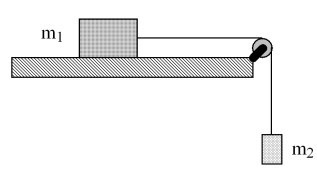
A)39.2 N
B)2.68 N
C)9.81 N
D)14.7 N
E)5.91 N

A)39.2 N
B)2.68 N
C)9.81 N
D)14.7 N
E)5.91 N

Unlock Deck
Unlock for access to all 86 flashcards in this deck.
Unlock Deck
k this deck
42
A mass m1 of 5.00 kg slides on a frictionless surface.This mass is connected to another mass m2 by a massless string over a frictionless pulley.The masses are held motionless and then released.Mass m2 accelerates downward at 4.10 m/s2.What is the mass of m2? 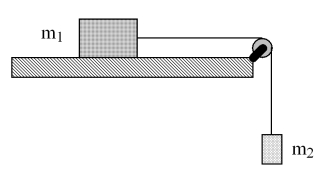
A)17.0 kg
B)3.59 kg
C)5.00 kg
D)6.96 kg
E)1.47 kg

A)17.0 kg
B)3.59 kg
C)5.00 kg
D)6.96 kg
E)1.47 kg

Unlock Deck
Unlock for access to all 86 flashcards in this deck.
Unlock Deck
k this deck
43
A cart slides down an incline without friction and then bounces off a bumper at the bottom.Assume that the coordinate system runs along the track with positive to the right. 
A)The acceleration should be -gsin along the track on the way down and -gsin on the way back.
B)The acceleration should be gsin along the track on the way down and -gsin on the way back.
C)The acceleration should depend on the mass of the cart.
D)The acceleration should be -gsin along the track on the way down and gsin on the way back.
E)The acceleration should be gsin along the track on the way down and gsin on the way back.

A)The acceleration should be -gsin along the track on the way down and -gsin on the way back.
B)The acceleration should be gsin along the track on the way down and -gsin on the way back.
C)The acceleration should depend on the mass of the cart.
D)The acceleration should be -gsin along the track on the way down and gsin on the way back.
E)The acceleration should be gsin along the track on the way down and gsin on the way back.

Unlock Deck
Unlock for access to all 86 flashcards in this deck.
Unlock Deck
k this deck
44
An object with mass 7.00 kg is being pushed up a rough inclined plane with a constant force F = 50.0 N.The plane makes an angle of 20.0 with respect to the horizontal.The object is moving with constant velocity.What is the coefficient of kinetic friction between the object and the surface? 
A)0.411
B)0.300
C)0.377
D)0.158
E)0.272

A)0.411
B)0.300
C)0.377
D)0.158
E)0.272

Unlock Deck
Unlock for access to all 86 flashcards in this deck.
Unlock Deck
k this deck
45
An object with mass 5.00 kg is being pushed up an inclined plane with a constant force
A)12.3 N
B)16.3 N
C)19.4 N
D)24.6 N
E)37.3 N
A)12.3 N
B)16.3 N
C)19.4 N
D)24.6 N
E)37.3 N

Unlock Deck
Unlock for access to all 86 flashcards in this deck.
Unlock Deck
k this deck
46
A mass M slides on a horizontal surface.A mass m is attached to a string routed over a pulley as shown below.Friction is present.When m is released,M accelerates to the right.The coefficient of friction between M and the surface is µk.Which one of the following statements is true? 
A)Doubling the mass of m will double the acceleration.
B)Doubling the mass of M will halve the acceleration.
C)µk will increase as mass M accelerates.
D)Doubling the mass of M will double the force of friction.
E)Doubling the mass of M will double µk.

A)Doubling the mass of m will double the acceleration.
B)Doubling the mass of M will halve the acceleration.
C)µk will increase as mass M accelerates.
D)Doubling the mass of M will double the force of friction.
E)Doubling the mass of M will double µk.

Unlock Deck
Unlock for access to all 86 flashcards in this deck.
Unlock Deck
k this deck
47
A mass,m1 slides on a frictionless surface.This mass is connected to another mass m2 of 5.00 kg by a massless string over a frictionless pulley.The masses are held motionless and then released.Mass m2 accelerates downward at 4.10 m/s2.What is the mass of m1? 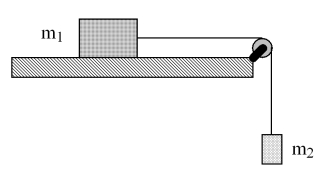
A)6.96 kg
B)1.47 kg
C)17.0 kg
D)3.59 kg
E)5.00 kg

A)6.96 kg
B)1.47 kg
C)17.0 kg
D)3.59 kg
E)5.00 kg

Unlock Deck
Unlock for access to all 86 flashcards in this deck.
Unlock Deck
k this deck
48
A box slides down a frictionless inclined plane.Starting from rest,the box slides a distance of 0.73 m and reaches a speed of 2.1 m/s.What is the angle of inclination of the plane with respect to the horizontal?
A)3.0 degrees
B)18 degrees
C)20 degrees
D)70 degrees
E)72 degrees
A)3.0 degrees
B)18 degrees
C)20 degrees
D)70 degrees
E)72 degrees

Unlock Deck
Unlock for access to all 86 flashcards in this deck.
Unlock Deck
k this deck
49
A person with a mass of 50 kg is standing on a scale in an elevator that is accelerating upwards at a rate of 3.2 m/s2.What is the reading on the scale (the apparent weight)?
A)50 N
B)160 N
C)330 N
D)490 N
E)650 N
A)50 N
B)160 N
C)330 N
D)490 N
E)650 N

Unlock Deck
Unlock for access to all 86 flashcards in this deck.
Unlock Deck
k this deck
50
A block with mass m is being pushed by a constant force F that makes an angle of with the horizontal as shown below.The block is moving with constant velocity on a level surface.The coefficient of kinetic friction between the block and the surface is µk.Which one of the following equations is correct for the magnitude of F? 
A)
B)
C)
D)
E)

A)

B)

C)

D)

E)


Unlock Deck
Unlock for access to all 86 flashcards in this deck.
Unlock Deck
k this deck
51
An object with mass m is hanging from a wire attached to the ceiling of an elevator.The elevator is moving downward and its speed is increasing at rate of a = 5 m/s2.Which one of the following statements is true? 
A)T=mg
B)T=mg-a
C)T=m(g-a)
D)T=m(g+a)
E)T=mg+a

A)T=mg
B)T=mg-a
C)T=m(g-a)
D)T=m(g+a)
E)T=mg+a

Unlock Deck
Unlock for access to all 86 flashcards in this deck.
Unlock Deck
k this deck
52
A mass m1 of 3.00 kg slides on a frictionless surface.This mass is connected to another mass m2 of 1.50 kg by a massless string over a frictionless pulley.The masses are held motionless and then released.What is the acceleration of m1 in m/s2? 
A)2.14
B)3.27
C)4.98
D)6.12
E)7.98

A)2.14
B)3.27
C)4.98
D)6.12
E)7.98

Unlock Deck
Unlock for access to all 86 flashcards in this deck.
Unlock Deck
k this deck
53
A box with a mass of 10 kg is sliding along the top of a rough,horizontal table at a speed of 30 m/s.The friction between the box and the table brings the box to rest in a time of 6.0 s.What is the coefficient of friction between the box and the table?
A)0.20
B)0.31
C)0.51
D)1.0
E)2.0
A)0.20
B)0.31
C)0.51
D)1.0
E)2.0

Unlock Deck
Unlock for access to all 86 flashcards in this deck.
Unlock Deck
k this deck
54
A 2.29-kg mass is suspended from a string which is pulled upward.The mass accelerates upwards with an acceleration of 2.30 m/s2.What is the tension in the string? (in N)
A)2.219 * 101
B)2.773 * 101
C)3.466 * 101
D)4.333 * 101
E)5.416 * 101
A)2.219 * 101
B)2.773 * 101
C)3.466 * 101
D)4.333 * 101
E)5.416 * 101

Unlock Deck
Unlock for access to all 86 flashcards in this deck.
Unlock Deck
k this deck
55
An 800-kg car traveling in a straight line at a speed of 30 m/s applies its brakes.During braking,there is a net force of 2000 N in the horizontal direction on the car.What distance will the car move from the time it applies its brakes until it has stopped?
A)12 m
B)75 m
C)180 m
D)300 m
E)60,000 m
A)12 m
B)75 m
C)180 m
D)300 m
E)60,000 m

Unlock Deck
Unlock for access to all 86 flashcards in this deck.
Unlock Deck
k this deck
56
A girl of mass 35 kg and boy of mass 25 kg are connected by a light rope.They move horizontally in a skating rink.A second rope is attached to the girl and with this second rope,she is pulled by a force of 300 N.The magnitude of their acceleration is
A)12 m/s2.
B)9.8 m/s2.
C)8.6 m/s2.
D)5.0 m/s2.
A)12 m/s2.
B)9.8 m/s2.
C)8.6 m/s2.
D)5.0 m/s2.

Unlock Deck
Unlock for access to all 86 flashcards in this deck.
Unlock Deck
k this deck
57
An elevator is moving upward with a constant acceleration of 1.2 m/s2.An object with mass 10.kg is hanging from the ceiling of the elevator on a string.What is the tension on the string in N? 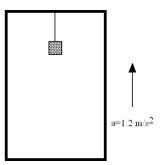
A)56
B)92
C)98
D)110
E)210

A)56
B)92
C)98
D)110
E)210

Unlock Deck
Unlock for access to all 86 flashcards in this deck.
Unlock Deck
k this deck
58
An object is being pushed up an inclined plane with a constant force F = 100.N.The plane makes an angle of 30.0 with respect to the horizontal.The object is moving with constant velocity.The coefficient of kinetic friction between the object and the surface is 0.300.What is the mass of the object? 
A)10.2 kg
B)24.4 kg
C)13.4 kg
D)5.00 kg
E)8.90 kg

A)10.2 kg
B)24.4 kg
C)13.4 kg
D)5.00 kg
E)8.90 kg

Unlock Deck
Unlock for access to all 86 flashcards in this deck.
Unlock Deck
k this deck
59
Given that the gravitational acceleration on the surface of the Moon is one-sixth that on the surface of the Earth,which of the following objects has the most mass?
A)a 1-kg object on the Earth
B)a 6-kg object on the Moon
C)a 6-kg object on the Earth
D)a 36-kg object on the Moon
A)a 1-kg object on the Earth
B)a 6-kg object on the Moon
C)a 6-kg object on the Earth
D)a 36-kg object on the Moon

Unlock Deck
Unlock for access to all 86 flashcards in this deck.
Unlock Deck
k this deck
60
You are riding an elevator that is moving upward with 3 m/s and slowing down at 2 m/s2.Your real weight is 490 N.Your apparent weight is
A)390 N.
B)490 N.
C)680 N.
D)980 N.
A)390 N.
B)490 N.
C)680 N.
D)980 N.

Unlock Deck
Unlock for access to all 86 flashcards in this deck.
Unlock Deck
k this deck
61
Consider two blocks hung by a massless string from a frictionless pulley as shown in the figure.The masses of the blocks are m1=5 kg and m2=7 kg.The bottoms of the blocks are 20 meters above the top of the table.When they are released from rest,how many seconds will it take for one of the blocks to hit the table (within 5% accuracy)? 
A)2
B)3
C)4
D)5
E)6

A)2
B)3
C)4
D)5
E)6

Unlock Deck
Unlock for access to all 86 flashcards in this deck.
Unlock Deck
k this deck
62
As shown in the figure,a person standing on the floor pulls on a rope with a force F at an angle of  (with respect to the positive x axis)in order to raise a weight with pulleys.It is raised at a constant velocity.Consider the rope as massless and the pulleys as frictionless.(The mass hanging from the lower pulley does not interfere with the movement of the pulley.)If the maximum tension the rope can withstand without is 100 N,what is the largest weight this pulley system can lift (within 5% accuracy)?
(with respect to the positive x axis)in order to raise a weight with pulleys.It is raised at a constant velocity.Consider the rope as massless and the pulleys as frictionless.(The mass hanging from the lower pulley does not interfere with the movement of the pulley.)If the maximum tension the rope can withstand without is 100 N,what is the largest weight this pulley system can lift (within 5% accuracy)? 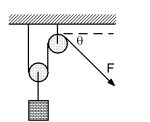
A)50 N
B)200 N
C)100 N
D)141 N
E)71 N
 (with respect to the positive x axis)in order to raise a weight with pulleys.It is raised at a constant velocity.Consider the rope as massless and the pulleys as frictionless.(The mass hanging from the lower pulley does not interfere with the movement of the pulley.)If the maximum tension the rope can withstand without is 100 N,what is the largest weight this pulley system can lift (within 5% accuracy)?
(with respect to the positive x axis)in order to raise a weight with pulleys.It is raised at a constant velocity.Consider the rope as massless and the pulleys as frictionless.(The mass hanging from the lower pulley does not interfere with the movement of the pulley.)If the maximum tension the rope can withstand without is 100 N,what is the largest weight this pulley system can lift (within 5% accuracy)? 
A)50 N
B)200 N
C)100 N
D)141 N
E)71 N

Unlock Deck
Unlock for access to all 86 flashcards in this deck.
Unlock Deck
k this deck
63
A sled of mass 10 kg starts out at an initial speed of 5 m/s on a horizontal surface.The coefficient of kinetic friction with the snow is 0.05.How far does it go before it comes to a stop (within 5% accuracy)?
A)25 m
B)50 m
C)320 m
D)640 m
E)1280 m
A)25 m
B)50 m
C)320 m
D)640 m
E)1280 m

Unlock Deck
Unlock for access to all 86 flashcards in this deck.
Unlock Deck
k this deck
64
Two forces are acting on an object and are shown in the diagram below.What is the net force acting on this object? Measure the direction counterclockwise from the 15 N force. 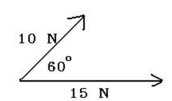
A)21.8 N at 23.4o
B)24.2 N at 40.0o
C)5.0 N at 20.0o
D)24.2 N at 11.9o
E)25.0 N at 20.0o

A)21.8 N at 23.4o
B)24.2 N at 40.0o
C)5.0 N at 20.0o
D)24.2 N at 11.9o
E)25.0 N at 20.0o

Unlock Deck
Unlock for access to all 86 flashcards in this deck.
Unlock Deck
k this deck
65
In the figure,a force F is being applied to the block with a magnitude such that it moves up along the frictionless inclined place with a constant velocity of 5 m/s.The angle in the figure is 30 ,and the mass of the block is 50 kg.What is the normal force exerted by the inclined plane on the block (within 5% accuracy)? 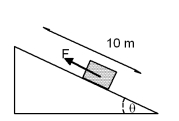
A)50 N
B)240 N
C)425 N
D)500 N
E)zero

A)50 N
B)240 N
C)425 N
D)500 N
E)zero

Unlock Deck
Unlock for access to all 86 flashcards in this deck.
Unlock Deck
k this deck
66
A sky diver has jumped from a plane and achieved a nearly constant velocity as she falls.Which statement below correctly explains how this happened.
A)She was high enough from the Earth that g was negligibly small.
B)She had reached equilibrium;the frictional force exceeded her weight.
C)Nearly constant velocity is an illusion caused by the very high velocity.
D)Terminal velocity occurred when the air was so thin that friction became negligible.
E)She reached equilibrium;the frictional force equaled her weight.
A)She was high enough from the Earth that g was negligibly small.
B)She had reached equilibrium;the frictional force exceeded her weight.
C)Nearly constant velocity is an illusion caused by the very high velocity.
D)Terminal velocity occurred when the air was so thin that friction became negligible.
E)She reached equilibrium;the frictional force equaled her weight.

Unlock Deck
Unlock for access to all 86 flashcards in this deck.
Unlock Deck
k this deck
67
A cart is being pushed down an incline with friction.What force F will accelerate it with the magnitude of the acceleration a = g down the incline? The quantities  and
and  are the coefficients of static and kinetic friction.
are the coefficients of static and kinetic friction. 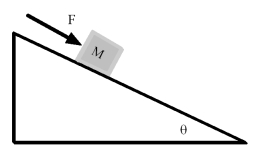
A)Mg
B)
C)
D)
E)
 and
and  are the coefficients of static and kinetic friction.
are the coefficients of static and kinetic friction. 
A)Mg
B)

C)

D)

E)


Unlock Deck
Unlock for access to all 86 flashcards in this deck.
Unlock Deck
k this deck
68
A 10-kg and a 4-kg mass are acted on by the same size net force (which remains constant)for the same period of time.Which one of the following statements is true?
A)The acceleration of the10-kg mass is 2.5 times greater than the acceleration of the 4-kg mass.
B)The acceleration of the 4-kg mass is 2.5 times greater than the acceleration of the 10-kg mass.
C)Both masses accelerate at the same rate.
D)The answer will depend on the length of the time interval.
E)None are correct.
A)The acceleration of the10-kg mass is 2.5 times greater than the acceleration of the 4-kg mass.
B)The acceleration of the 4-kg mass is 2.5 times greater than the acceleration of the 10-kg mass.
C)Both masses accelerate at the same rate.
D)The answer will depend on the length of the time interval.
E)None are correct.

Unlock Deck
Unlock for access to all 86 flashcards in this deck.
Unlock Deck
k this deck
69
An object of mass m is at rest on a horizontal surface,and the coefficient of static friction is  and kinetic friction
and kinetic friction  .If a force F is applied to the object as shown and it remains at rest,then it must be true that
.If a force F is applied to the object as shown and it remains at rest,then it must be true that 
A)
B)
C)
D)
E)
 and kinetic friction
and kinetic friction  .If a force F is applied to the object as shown and it remains at rest,then it must be true that
.If a force F is applied to the object as shown and it remains at rest,then it must be true that 
A)

B)

C)

D)

E)


Unlock Deck
Unlock for access to all 86 flashcards in this deck.
Unlock Deck
k this deck
70
Two forces have magnitude 10 and 15 N and point as shown in the diagram.What is the magnitude of a third force which would exactly balance these two forces? That is,make the sum of the three forces zero. 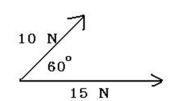
A)21.8
B)5.0
C)25.0
D)12.3
E)33.4

A)21.8
B)5.0
C)25.0
D)12.3
E)33.4

Unlock Deck
Unlock for access to all 86 flashcards in this deck.
Unlock Deck
k this deck
71
A person with a mass of 100 kg is going down in an elevator with a constant velocity of -9.8 m/s.Which of the following is true (chose one).
A)The weight of the person is zero.
B)The weight of the person is 100 Newtons.
C)The weight of the person is 980 Newtons.
D)The weight of the person is 980 kg.
E)The weight of the person is 100 pounds.
A)The weight of the person is zero.
B)The weight of the person is 100 Newtons.
C)The weight of the person is 980 Newtons.
D)The weight of the person is 980 kg.
E)The weight of the person is 100 pounds.

Unlock Deck
Unlock for access to all 86 flashcards in this deck.
Unlock Deck
k this deck
72
Consider two blocks hung by a massless string from a frictionless pulley as shown in the figure.The masses of the blocks are m1=5 kg and m2=7 kg.The bottoms of the blocks are 20 meters above the top of the table.While m2 is moving downward,what is the magnitude of its acceleration (within 5% accuracy)? 
A)9.8 m/s2
B)2.8 m/s2
C)7.0 m/s2
D)0 m/s2
E)1.6 m/s2

A)9.8 m/s2
B)2.8 m/s2
C)7.0 m/s2
D)0 m/s2
E)1.6 m/s2

Unlock Deck
Unlock for access to all 86 flashcards in this deck.
Unlock Deck
k this deck
73
Two forces have magnitude 10 and 15 N and point as shown in the diagram.What is the direction of a third force which would exactly balance these two forces? That is,make the sum of the three forces zero.Measure the direction counterclockwise from the 15 N force. 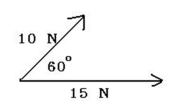
A)240o
B)236o
C)60.0o
D)203o
E)214o

A)240o
B)236o
C)60.0o
D)203o
E)214o

Unlock Deck
Unlock for access to all 86 flashcards in this deck.
Unlock Deck
k this deck
74
Consider two blocks hung by a massless string from a frictionless pulley as shown in the figure.The masses of the blocks are m1=5 kg and m2=7 kg.The bottoms of the blocks are 20 meters above the top of the table.While m2 is accelerating downward,what is the magnitude of the tension in the string (within 5% accuracy)? 
A)57 N
B)49 N
C)69 N
D)80 N
E)5

A)57 N
B)49 N
C)69 N
D)80 N
E)5

Unlock Deck
Unlock for access to all 86 flashcards in this deck.
Unlock Deck
k this deck
75
Two masses,m1 = 10,000 kg and m2 = 300,000 kg,in space exert forces on each other.What is a2,the acceleration of m2? The force on m1 due to m2,F,is 900,000 N and is in the positive x-direction. 
A)90 m/s2
B)3 m/s2
C)900 m/s2
D)-3 m/s2
E)-90 m/s2

A)90 m/s2
B)3 m/s2
C)900 m/s2
D)-3 m/s2
E)-90 m/s2

Unlock Deck
Unlock for access to all 86 flashcards in this deck.
Unlock Deck
k this deck
76
The mass in the picture below is sliding up the incline with no external forces applied.Which diagram for the forces along the incline is correct? 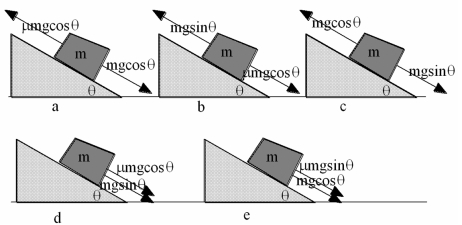
A)a
B)b
C)c
D)d
E)e

A)a
B)b
C)c
D)d
E)e

Unlock Deck
Unlock for access to all 86 flashcards in this deck.
Unlock Deck
k this deck
77
As shown in the figure,a person standing on the floor pulls on a rope with a force F at an angle of  (with respect to the positive x axis)in order to raise a weight of 30 N with pulleys.It is raised at a constant velocity.Consider the rope as massless and the pulleys as frictionless.(The mass hanging from the lower pulley does not interfere with the movement of the pulley.)What is the tension in the rope (within 5% accuracy)?
(with respect to the positive x axis)in order to raise a weight of 30 N with pulleys.It is raised at a constant velocity.Consider the rope as massless and the pulleys as frictionless.(The mass hanging from the lower pulley does not interfere with the movement of the pulley.)What is the tension in the rope (within 5% accuracy)? 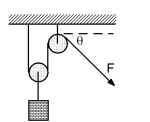
A)5 N
B)10 N
C)15 N
D)21 N
E)30 N
 (with respect to the positive x axis)in order to raise a weight of 30 N with pulleys.It is raised at a constant velocity.Consider the rope as massless and the pulleys as frictionless.(The mass hanging from the lower pulley does not interfere with the movement of the pulley.)What is the tension in the rope (within 5% accuracy)?
(with respect to the positive x axis)in order to raise a weight of 30 N with pulleys.It is raised at a constant velocity.Consider the rope as massless and the pulleys as frictionless.(The mass hanging from the lower pulley does not interfere with the movement of the pulley.)What is the tension in the rope (within 5% accuracy)? 
A)5 N
B)10 N
C)15 N
D)21 N
E)30 N

Unlock Deck
Unlock for access to all 86 flashcards in this deck.
Unlock Deck
k this deck
78
Three blocks with masses of 1 kg,2 kg,and 3 kg are sliding down a plane inclined at an angle = 25 .If the coefficient of kinetic friction is the same for each of the blocks,which block has the greatest acceleration along the plane?
A)They all have the same acceleration
B)the 1-kg block
C)the 2-kg block
D)the 3-kg block
E)the 2- and 3-kg blocks
A)They all have the same acceleration
B)the 1-kg block
C)the 2-kg block
D)the 3-kg block
E)the 2- and 3-kg blocks

Unlock Deck
Unlock for access to all 86 flashcards in this deck.
Unlock Deck
k this deck
79
Consider two blocks hung by a massless string from a frictionless pulley as shown in the figure.The masses of the blocks are m1=5 kg and m2=7 kg.The bottoms of the blocks are 20 meters above the top of the table.What is the speed of m2 just before it strikes the table 20 meters below its starting point (within 5% accuracy)? 
A)22 m/s
B)8.1 m/s
C)20.m/s
D)11.m/s
E)1.7 m/s

A)22 m/s
B)8.1 m/s
C)20.m/s
D)11.m/s
E)1.7 m/s

Unlock Deck
Unlock for access to all 86 flashcards in this deck.
Unlock Deck
k this deck
80
Consider two blocks hung by a massless string from a frictionless pulley as shown in the figure.The mass of block m1 is 5 kg.The bottoms of the blocks are 20 meters above the top of the table.Mass m2 accelerates downward at 3.5 m/s2.What is the mass of m2? 
A)15.0 kg
B)5.0 kg
C)12.3 kg
D)10.5 kg
E)17.3 kg

A)15.0 kg
B)5.0 kg
C)12.3 kg
D)10.5 kg
E)17.3 kg

Unlock Deck
Unlock for access to all 86 flashcards in this deck.
Unlock Deck
k this deck



